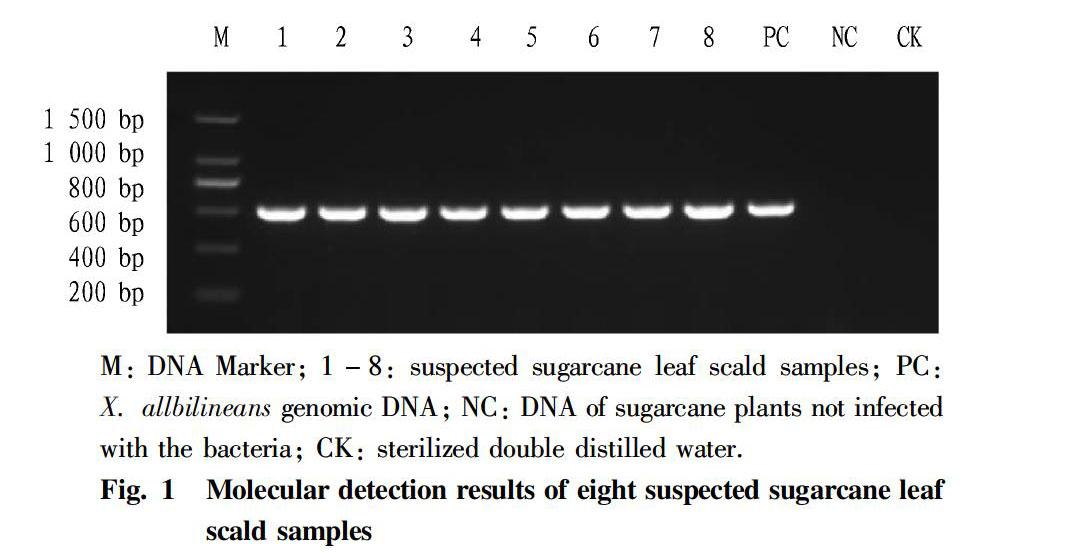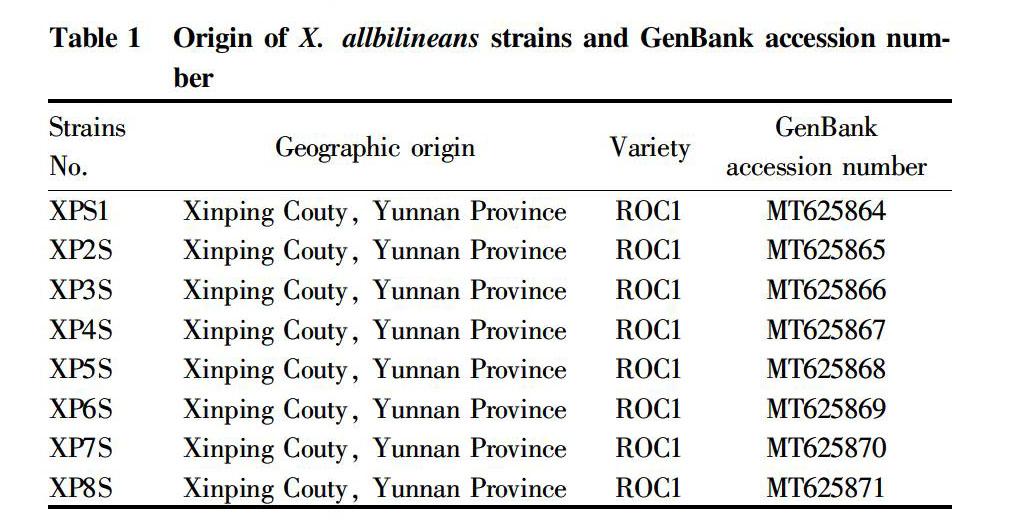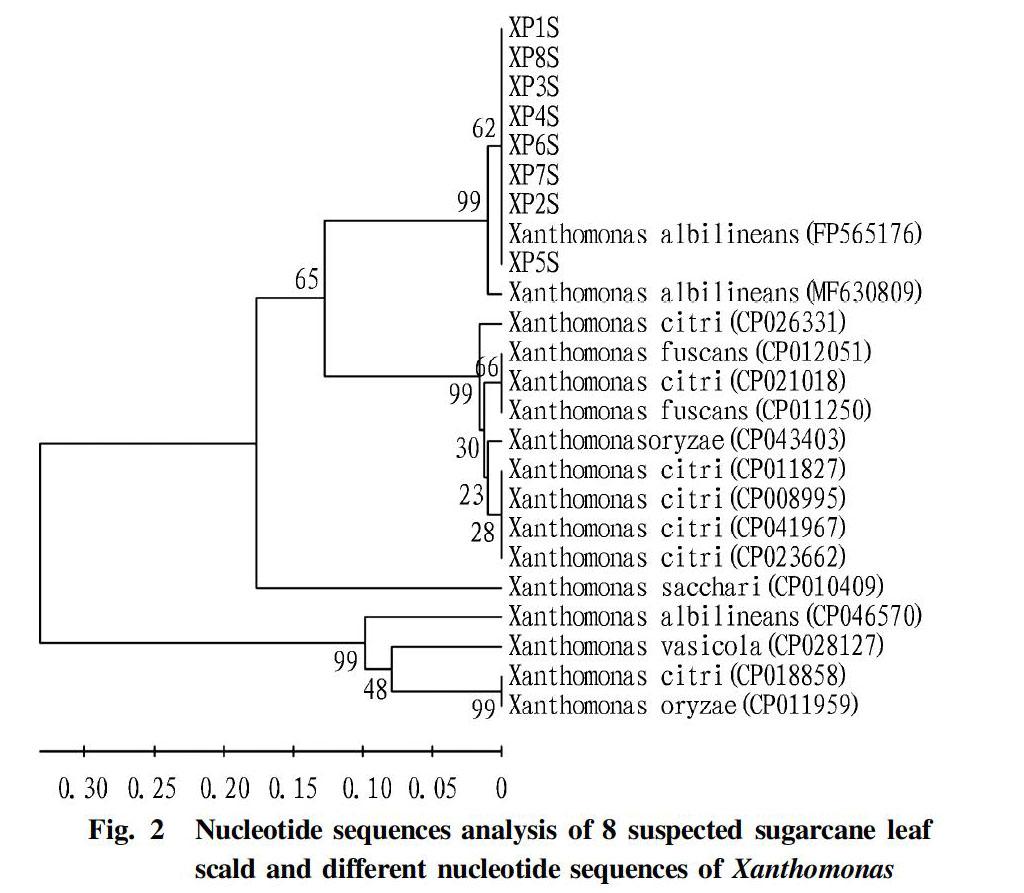The Quarantine Disease Sugarcane Leaf Scald Found in Xinping Sugarcane Area in Yunnan Province
2021-08-02JiarongPUChangmiWANGJinanPURongyueZHANGZhaoguiYANGXiaoyanWANGHongliSHANXiaoyanCANGYingkunHUANG
Jiarong PU Changmi WANG Jinan PU Rongyue ZHANG Zhaogui YANG Xiaoyan WANG Hongli SHAN Xiaoyan CANG Yingkun HUANG



Abstract [Objectives] This study was conducted to clarify the pathogens causing suspected sugarcane leaf scald symptoms in sugarcane plants found in the Xinping sugarcane area of Yunnan in 2019.
[Methods]The XAF1/XAR1 specific primers of Xanthomonas albilineans were used to detect 8 suspected samples from Xinping County, Yunnan Province.
[Results] The specific band 600 bp in size was detected. The sequencing results showed that the sequences detected were all 608 bp, and were 100% identical. The BLAST search results showed that the obtained sequence was 100% identical to the nucleotide sequence of X. albilineans GPE PC73 strain (GenBank accession number: FP565176) from France, and they were located in the same branch of the phylogenetic tree. According to the field symptom diagnosis and molecular identification results, the sugarcane disease in Xinping, Yunnan was confirmed to be the quarantine disease sugarcane leaf scald caused by X. allbilineasn.
[Conclusions]The pathogens were identified by molecular biological identification methods, providing a scientific basis for the prevention and control of leaf scald disease in the future.
Key words Yunnan Province; Xinping County; Sugarcane leaf scald; BLAST comparison; Phylogeny
Received: December 21, 2020 Accepted: February 25, 2021
Supported by Special Fund for Construction of Sugar Crop Research System (CARS-170303); Yunling Industrial Technology Leading Talent Training Project: Sugarcane Pest Control (2018LJRC56); Special Fund for the Construction of Modern Agricultural Industry Technology System in Yunnan Province.
Jiarong PU (1970-), male, P. R. China, senior agronomist, devoted to research about promotion of sugarcane technology.
Changmi WANG (1991-), male, P. R. China, research assistant, master, devoted to research about sugarcane diseases.
#These authors contributed equally to this work.
*Corresponding author. E-mail: huangyk64@163.com.
Sugarcane leaf scald is one of the three major bacterial diseases of sugarcane, a systemic vascular bacterial disease caused by Xanthomonas albilineans[1]. The X. albilineans pathogen belongs to obligate aerobic gram-negative bacteria, and its colonies have the characteristics of smooth surface, round shape, light yellow or honey yellow color, and viscous bacterial liquid[2]. X. albilineans can colonize the roots, stems and leaves of sugarcane, and invade the xylem to produce Xanthomonas toxin, which blocks the differentiation of chloroplasts and form white stripes, resulting in a substantial decrease in sugarcane yield and quality[3-4]. The deletion of the leaf scald Xanthomonas toxin gene will weaken its pathogenicity, so there is an incubation period that does not show symptoms for several months or even years[5]. X. albilineans causes buds to grow out, lateral branches to grow in the middle and lower parts of sugarcane, and tillers to appear at the base of stems, and single stripes with obvious white contours appear on leaves on lateral branches, tillers and main stems, which can cause plant death and other symptoms in severe cases[3].
The disease was first reported in Java, Indonesia, Australia and Fiji in the 1820s, and it has now widely occurred in at least 66 countries including the United States, Cuba, Brazil, Australia, France, India and Pakistan[6]. In 1980, it was reported in Fujian, Guangdong, Jiangxi, Hainan, Taiwan and other sugarcane production areas[7-9]. In 2017, Li et al.[10] used molecular biology techniques to detect the pathogen of sugarcane leaf scald in the sugarcane areas of Beihai, Laibin and Baise in Guangxi for the first time. In 2019, Zhang et al.[2] also found leaf scald on sugarcane in Baoshan, Mengding and Jinping sugarcane regions of Yunnan through the isolation and molecular biological identification of original bacteria. In 2019, diseases suspected of leaf scald were discovered in Xinping County, Yunnan Province, and in order to clarify the pathogens of these diseases, they were identified by molecular biological identification methods, providing a scientific basis for the prevention and control of leaf scald in the future.
Materials and Methods
Leaf scald samples
In 2019, 8 samples of ROC1 suspected of sugarcane leaf scald were collected from the Xinping sugarcane area in Yunnan Province, and numbered XP1S, XP2S, XP3S, XP4S, XP5S, XP6S, XP7S, and XP8S, respectively.
Total DNA extraction
The surface of cane stems was washed with tap water 3 times to remove the surface dirt, disinfected with 75% ethanol for 20 s, and burned with fire to remove the surface ethanol. The surface disinfection was repeated twice. The cane stems were cut into pieces of 5-8 cm, and cane juice was collected by squeezing. A certain amount of the cane juice (2 ml) was pipetted into a centrifuge tube, and centrifuged at 12 000 r/min for 10 min. The supernatant was discarded, and total DNA was extracted from the sugarcane juice precipitate using a plant genomic DNA extraction kit (Tiangen Biotech (Beijing) Co., Ltd.).
PCR and detection
PCR was performed with the total DNA of cane juice as a template, combining with the specificity of the sequence of the adenosine triphosphate-binding cassette transporter gene (abc, XALc_1791) primers in X. albilineans GPE PC73 strain genome (XAF1: 5′-CCTGGTGATGACGCTGGGTT-3′,XAR1:5′-CGATCAGCGATGCACGCAGT-3′). The PCR products were detected by 1.5% agarosegel electrophoresis.
PCR product purification and cloning
The PCR products were recovered using the gel recovery kit (Beijing TransGen Biotech Co., Ltd.), and then 4 μl of the product was gently mixed with 1 μl of pEASY-T5 cloning vector (Beijing TransGen Biotech Co., Ltd.), obtaining a mixture, which reacted at 37 ℃ for 5 min. The centrifuge tube was placed on ice after the reaction was completed. The ligation product was added with the 50 μl of Trans1-T1 competent cells that had just been thawed, obtaining a mixture, which was mixed by flicking, placed in an ice bath for 30 min, subjected to heat shock in a 42 ℃ water bath for 30 s, and placed on ice immediately. Next, 250 μl of LB medium was added to the centrifuge tube, followed by incubation at 37 ℃for 1 h at 200 rpm. Then, a 200 μl bacterial liquid was pipetted on LB medium with 50 ng/ml ampicillin, and cultivated overnight in a 37 ℃ incubator. Eight transformants were picked from each clone for PCR positive clone detection. Five positive clones were selected and sent to BGI for gene sequencing.
Sequencing and analysis
The obtained sequences were searched by BLAST on the NCBI official website, and DNAMAN8.0 was used for sequence identity analysis. The MEGAV8.0 software was used to build a phylogenetic tree[11] by the neighbor-joining method in the mode of Kimura2-parameter, in which the bootstrap was repeated 1 000 times. We uploaded the cloned sequence to the NCBI website and applied for the sequence GenBank accession number.
Results and Analysis
PCR detection of suspected sugarcane leaf scald samples
The molecular detection of the 8 suspected sugarcane leaf scald samples from Xinping was performed through the specificity of the XAF1/XAR1 primer pair, and the results shown in Fig. 1 were obtained. The 8 samples and the positive control were all amplified, a target band of about 600 bp in size was obtained, while the negative control and water control did not show the target band of about 600 bp in size. The results showed that all 8 samples were suspected to contain X. allbilineans pathogen.
Clone sequencing and analysis
In order to further clarify the sources of the X. allbilineans pathogens of the 8 suspected leaf scald disease samples, the bacterial liquids of 5 positive clones were randomly selected for sequencing. The sequencing results showed that the sequences of the eight suspected leaf scald disease samples were all 608 bp, and all the sequences were 100% identical. The sequence of the 8 samples was uploaded to NCBI to obtain the GenBank accession number shown in Table 1. The BLAST search results showed that the obtained sequence was 100% identical to the nucleotide sequence of X. albilineans GPE PC73 strain (GenBank accession number: FP565176) from France. A phylogenetic tree was constructed using the obtained sequence and other Xanthomonas species searched (Fig. 2). The results showed that the sequence obtained in this study was in the same branch as the X. allbilineans strain, but was clearly distinguished from other Xanthomonas species. Therefore, the results showed that the disease in the 8 suspected sugarcane leaf scald samples in this study was sugarcane leaf scald disease, and the pathogen was X. albilineans.
Conclusions and Discussion
Sugarcane leaf scald disease is an important disease of sugarcane caused by X. albilineans. In this study, XAF1/XAR1 specific primers XAF1/XAR1 were used to molecularly identify 8 suspected leaf scald disease strains collected from Xinping sugarcane area in Yunnan Province. According to the field symptom diagnosis and molecular identification results, the sugarcane disease in Xinping County, Yunnan Province was confirmed to be the quarantine disease sugarcane leaf scald caused by X. allbilineasn.
Sugarcane leaf scald disease is a hidden quarantine disease that is easily spread with seedlings, and has a long incubation period and a hidden nature. Therefore, strengthening the quarantine and inspection of introduced varieties and complementing the shortcomings of quarantine of introduced varieties, blocking the spread of X. albilineans from the source is one of the important means to block the introduction of foreign sugarcane diseases into China. Meanwhile, we should grasp the incidence and prevalence laws of leaf scald disease in various sugarcane areas, strengthen the detection of leaf scald disease and varieties to be introduced, and do a good job in prevention as early as possible, so as to control the occurrence and harm of leaf scald disease below the threshold. Breeding of resistant varieties is one of the most economical and effective ways to prevent and control leaf scald disease. This study can lay a foundation for the breeding of varieties resistant to leaf scald disease and prevention and control of leaf scald disease in the future. The first report of leaf scald disease in Xinping sugarcane area in Yunnan provides a scientific basis for in-depth research and prevention and control of leaf scald disease in the future.
References
[1] LIN LH. Isolation and identification of causal pathogen of sugarcane leaf scald and evaluation of disease-resistance of new sugarcane clones in China[D]. Fuzhou: Fujian Agriculture and Forestry University, 2019. (in Chinese)
[2] ZHANG RY, LI WF, WANG XY, et al. Identification of sugarcane leaf scald based on multiple gene sequences in Yunnan Province [J]. Plant Protection, 2019, 45(1): 181-185, 215. (in Chinese)
[3] ROTT P, SANDHU HS, COMSTOCK JC, et al. Sugarcane leaf scald disease[J]. University of Florida IFAS Extension: SS-AGR-201. 2017.
[4] BIRCH RG. The relation of blocked chloroplast differentiation to sugarcane leaf scald disease[J]. Phytopathology, 1983, 73(10): 1368-1374.
[5] BIRCH RG, PATIL SS. Correlation between albicidin production and chlorosis induction by Xanthomonas albilineans, the sugarcane leaf scald pathogen[J]. Physiological & Molecular Plant Pathology, 1987, 30(2):199-206.
[6] WITZGALL P, STELINSKI L, GUT L, et al. Codling moth management and chemical ecology[J]. Annual Review of Entomology, 2008, 53(1): 5032-5052.
[7] LU GD, LI CC. List of sugarcane diseases in China[J]. Subtropical Agriculture Research, 1997(4):19-23. (in Chinese)
[8] ZHANG RY, WANG XY, SHAN HL, et al. Identification and phylogenetic analysis of Xanthomonas albilineans (Ashby) Dowson based on multiple gene sequences in Yunnan Province, China[J]. Sugar Tech, 2019, 21(5): 794-801.
[9] ZHANG RY, SHAN HL, LI WF, et al. First report of sugarcane leaf scald caused by Xanthomonas albilineans (Ashby) Dowson in the province of Guangxi, China[J]. Plant Disease, 2017, 101(8): 1541.
[10] LI WF, SHAN HL, ZHANG RY, et al. Sugarcane leaf scald disease found in Guangxi sugarcane region[J]. Chinese Agricultural Science Bulletin, 2018, 34(13): 144-149. (in Chinese)
[11] LU WJ, LI WF, HUANG YK, et al. Quarantine and molecular detection for quarantine pest on exotic sugarcane varieties[J]. Journal of Yunnan Agricultural Unversity, 2009, 24(6): 804-808. (in Chinese)
杂志排行
农业生物技术(英文版)的其它文章
- Anti-inflammatory Activity and Mechanism of Total Flavonoids from the Phloem of Paulownia elongate S.Y. Hu in LPS-stimulated RAW264.7 Macrophages
- Comparative Genomic Analysis of Boron Transport Gene Family in Arabidopsis and Five Crops
- Effects of Different Water-saving Irrigation Methods on Fruit Quality and Yield of Snow Melon
- Field Control Effects and Crop Safety Assessment of Triazole Fungicides on Apple Rust
- Effects of Acetylacetone Solution Soaking on Agrobacterium-transformed Maize Seed Buds
- Effects of Meteorological Factors on Overwintering Ability, Yield and Quality of Forage Rape
